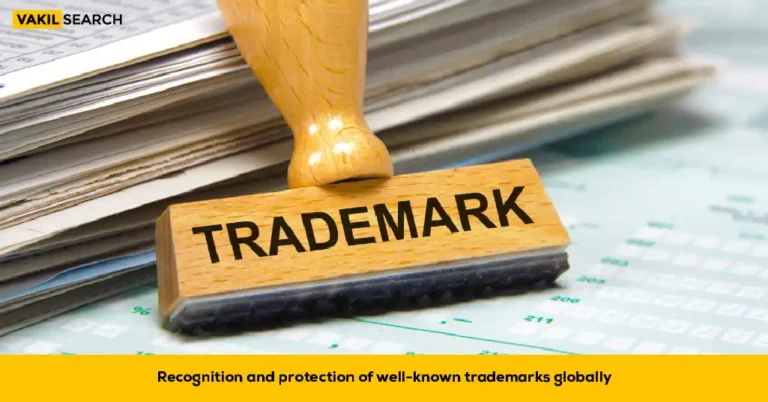Explore WIPO's role in managing well-known trademarks. In this comprehensive guide, we cover everything from international agreements, arbitration and mediation services, to policy development efforts aimed at safeguarding intellectual property rights on a global scale.
The protection and enforcement of well-known trademarks have become increasingly crucial in today’s global marketplace, where brands strive to maintain their distinctiveness and reputation amidst growing competition and evolving consumer preferences. Recognizing the significance of well-known trademarks, international agreements and organizations, such as the World Intellectual Property Organization (WIPO), play a vital role in establishing frameworks for their protection and enforcement.
In this article, we will explore the role of WIPO trademark in safeguarding well-known trademarks, examining relevant international agreements, legal principles, and practical considerations.
Understanding Well-Known Trademarks and International Agreements
The concept of well-known trademarks finds its roots in international agreements such as the Paris Convention for the Protection of Industrial Property and the Agreement on Trade-Related Aspects of Intellectual Property Rights (TRIPS), both administered by WIPO trademark. Article 6bis of the Paris Convention provides a special protective regime for well-known marks, allowing countries to refuse or cancel the registration of marks likely to create confusion with well-known marks.
Similarly, Article 16 of the TRIPS Agreement extends protection to well-known marks, emphasizing the need to prevent unauthorized use that could damage the interests of the mark owner.
Defining Well-Known Trademarks
While international agreements recognize the importance of well-known trademarks, the definition of what constitutes a well-known mark may vary across jurisdictions. WIPO trademark itself does not provide a specific definition of well-known trademarks but acknowledges the criteria used by member states to determine well-knownness. Factors such as the degree of knowledge, duration of use, extent of advertising, and global registration history are considered in assessing the renown of a mark. Additionally, WIPO’s Joint Resolution on well-known marks offers guidance on factors to be taken into account when determining the status of a mark as well-known.
Protection Against Bad Faith Registrations
One of the significant challenges faced by owners of well-known trademarks is the proliferation of unauthorized registrations by third parties, particularly in emerging markets. WIPO trademark addresses this issue by advocating for the protection of well-known marks against bad faith registrations. Article 3 of WIPO’s Joint Resolution emphasizes the need for member states to safeguard well-known marks against conflicting registrations, ensuring that legitimate owners are not unfairly disadvantaged by unauthorized registrations.
Addressing Conflicting Marks, Business Identifiers, and Domain Names
Conflicts between well-known trademarks and other identifiers, such as business names and domain names, present significant challenges for trademark owners seeking to protect their intellectual property rights. To address these challenges, the World Intellectual Property Organization (WIPO) has developed guidelines outlined in its Joint Resolution, offering a framework for resolving conflicts involving marks, business identifiers, and domain names.
Article 4 of WIPO’s Joint Resolution delineates the conditions under which marks are considered to be in conflict with well-known marks. This includes assessing factors such as the likelihood of confusion, impairment of distinctive character, and unfair advantage. When determining conflict, the resolution aims to balance the rights of well-known mark owners with the interests of other parties.
Similarly, Articles 5 and 6 of the Joint Resolution focus on conflicts involving business identifiers and domain names, respectively. Article 5 addresses conflicts related to business identifiers, which encompass signs identifying businesses rather than products or services. It emphasizes the need for equitable resolution that safeguards the interests of well-known mark owners while considering the legitimate interests of businesses using the identifiers.
Article 6 specifically deals with conflicts arising from domain names, recognizing the growing importance of online presence and digital branding. It underscores the necessity for fair and balanced resolution mechanisms to address disputes over domain names that may infringe upon well-known trademarks. Such resolution mechanisms aim to uphold the integrity of well-known marks while ensuring due process for all parties involved.
In essence, WIPO’s Joint Resolution provides a comprehensive framework for addressing conflicts between well-known trademarks and other identifiers. By considering factors such as likelihood of confusion, impairment of distinctive character, and unfair advantage, WIPO seeks to promote fairness and equity in resolving disputes, thereby protecting the interests of well-known mark owners in the global marketplace.
Local Idiosyncrasies and Dilution Concerns
WIPO recognizes the importance of considering local idiosyncrasies and cultural factors when assessing the well-known status of trademarks in different jurisdictions. While a mark may enjoy significant reputation globally, its recognition and distinctiveness in a particular country or region may vary. Moreover, concerns related to dilution, both in terms of blurring and tarnishment, underscore the need for robust protection mechanisms to preserve the integrity of well-known marks. WIPO encourages member states to adopt measures to prevent dilution and ensure that well-known trademarks retain their distinctive character and reputation.
Conclusion: WIPO Trademark
In conclusion, WIPO Trademark plays a central role in promoting the protection and enforcement of well-known trademarks on the international stage. Through agreements such as the Paris Convention and TRIPS, as well as initiatives like the Joint Resolution on well-known marks, WIPO provides a framework for member states to address the challenges posed by unauthorized registrations, conflicting identifiers, and dilution concerns.
By facilitating cooperation and harmonization among countries, WIPO trademark contributes to creating a more conducive environment for brand owners to safeguard their valuable intellectual property assets.
As the global marketplace continues to evolve, WIPO’s ongoing efforts remain crucial in ensuring the continued protection and recognition of well-known trademarks worldwide.










